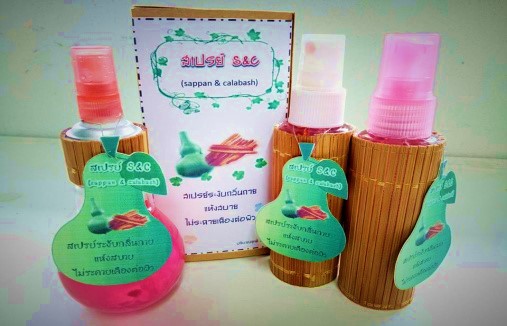การเรียนรู้แบบโครงงานที่ใช้ชุมชนเป็นฐานในรายวิชาเคมีผลิตภัณฑ์ท้องถิ่น
Main Article Content
Abstract
Thanyanan Sripanlom, Kulthida Nugultham and Nantarat Kruea–In
รับบทความ: 22 กุมภาพันธ์ 2562; แก้ไขบทความ: 3 กันยายน 2562; ยอมรับตีพิมพ์: 15 กันยายน 2562
บทคัดย่อ
การวิจัยครั้งนี้มีวัตถุประสงค์เพื่อส่งเสริมความคิดสร้างสรรค์ในรายวิชาเคมีผลิตภัณฑ์ท้องถิ่นด้วยการจัดการเรียนรู้ผ่านโครงงานที่ใช้ชุมชนเป็นฐานสำหรับนักศึกษาระดับปริญญาตรี กลุ่มเป้าหมาย ได้แก่ นักศึกษาชั้นปีที่ 3 สาขาวิชาเคมี มหาวิทยาลัยราชภัฏนครปฐม จำนวน 32 คน โดยใช้วิธีการเลือกแบบเจาะจง เครื่องมือที่ใช้ในการวิจัยประกอบด้วย 1) รายวิชาเคมีผลิตภัณฑ์ท้องถิ่นโดยจัดการเรียนรู้ผ่านโครงงานที่ใช้ชุมชนเป็นฐานประกอบด้วย 5 ขั้นตอน คือ การเชื่อมโยงภูมิปัญญาท้องถิ่นและความรู้เกี่ยวกับผลิตภัณฑ์จากธรรมชาติสู่ห้องเรียน การพัฒนาความคิดเกี่ยวกับผลิตภัณฑ์ใหม่โดยผ่านกิจกรรมเพื่อส่งเสริมความคิดสร้างสรรค์ การสร้างผลิตภัณฑ์ใหม่ การออกแบบ วางแผนการทดลอง และทดสอบมาตรฐานผลิตภัณฑ์ และการประเมินผลิตภัณฑ์โดยผู้เชี่ยวชาญจากชุมชน และ 2) แบบประเมินผลิตภัณฑ์จำนวน 26 ข้อ ดัดแปลงมาจาก The creative solution diagnosis scale (CSDS) ของ Cropley et al. (2011) และ creativity measurement tool (CMeT) ของ Majid et al. (2015) ผล การวิจัยพบว่าการจัดการเรียนการสอนผ่านโครงงานที่ใช้ชุมชนเป็นฐานนี้ สามารถพัฒนานักศึกษาให้ ได้รับประสบการณ์การทำงานในสภาพจริงที่ต้องเชื่อมโยงแนวคิดวิทยาศาสตร์ไปสู่การสร้างผลิตภัณฑ์ทั้งในระดับการใช้งานในชีวิตประจำวันไปจนถึงในเชิงพาณิชย์ นักศึกษามีโอกาสในการเข้าถึงแหล่งข้อมูลท้องถิ่นในการพัฒนาและต่อยอดทางความคิด แลกเปลี่ยนเรียนรู้จากชุมชน และใช้ทรัพยากร ภูมิปัญญาที่มีอยู่ในชุมชนนั้นมาสร้างเป็นชิ้นงานได้อย่างสร้างสรรค์ และผลการประเมินความคิดสร้างสรรค์ของผลิตภัณฑ์มีระดับคะแนนเฉลี่ย 82.01 มากกว่าเกณฑ์ร้อยละ 80 (p < 0.05)
คำสำคัญ: การเรียนรู้แบบโครงงานที่ใช้ชุมชนเป็นฐาน เคมีผลิตภัณฑ์ท้องถิ่น ความคิดสร้างสรรค์
Abstract
The purpose of this research was to promote creativity by using community–based project learning in local chemistry product course for undergraduate chemistry students. It focused on the implementation of all branch of chemistry knowledge to innovate the natural product. The target group was thirty–two junior students from chemistry program, Nakhon Pathom Rajabhat University by using purposive sampling. The instruments used in the study were 1) The course was design by using community-based project learning which were consist of 5 steps: link the community wisdom knowledge of natural product to the classroom; practice the new idea by creativity shot program; raise up the new products; plan the experiment and test the product; communicate and valuate by the community, and 2) the product assessment form with 26 questions adapted from the creative solution diagnosis scale (CSDS) of Cropley et al. (2011) and others and Creativity Measurement Tool (CMeT) of Majid et al. (2015). The research results showed that the teaching and learning through this community–based project able to develop students to gain real–life work experience that connected science concepts to product creation from daily use to commercial levels. Moreover, students had the opportunity to access local information for further development of ideas, exchange knowledge from the community, and used local resources and wisdom in that community to make creative products. The average score of creative products was 82.01 percent more than the criteria of 80 percent (p < .05).
Keywords: Community–based project learning, Local chemistry product, Creativity
Downloads
Article Details

This work is licensed under a Creative Commons Attribution-NonCommercial 4.0 International License.
References
Cropley, D. H., Kaufman, J. C., and Cropley, A. J. (2011). Measuring Creativity for Innovation Management. Journal of Technology Management & Innovation 6(3): 13–30.
Draper, A. J. (2004). Integrating project–Based Service-Learning into an Advanced Environmental Chemistry Course. Journal of Chemical Education 81(2): 221-224.
Eyler, J. (2009). Effective Practices and Experiential Education. Retrieved from http://commons.clarku.edu/mosakowskiinstitute, October 25, 2015.
Fischer, G., Rohde, M., and Wulf, V. (2007). Community–based learning: The core competency of residential, research–based university. Computer–Supported Collaborative Learning 2(1): 9–40.
Glaveane, V. P. (2012). Creativity development in community contexts: The case of folk art. Thinking Skill and Creativity 9: 152–164.
Janjamsai, M. (2015). Community based learning case study: Integration of architectural design learning and low–income housing development (Baan Munkong: Project at Rama 9 Sump 3 Community). Area Based Development Research Journal 7(3): 106–117. (in Thai)
Karathanos, P., Karathanos, D., and Rohatgi, J. (2004). Imagination: An organization’s treasure. Industrial Management 46(4): 16–21.
Lazarus, J. (2005). Community engagement and service learning in South African higher education. Paper delivered at the SAAR DHE Conference. Durban, South Africa: National Qualification Framework.
Majid, N. A. S., Kassim, H., and Razak, M. A. (2015). Evaluating the creativity of a pro-duct using creativity measurement tool (CMET). E–proceeding of the International Conference on Social Science Re-search, ICSSR 2015 (pp.257–263). Malaysia: Center for Modern Languages and Human Sciences University Malaysia Pahang.
Osborn, A. (1988). Applied Imagination. 3rd ed. New York: Scribners.
Owens, T. R., and Wand, C. (1996). Community–based Learning: A Foundation for Meaningful Educational Reform. Retrieved from http://digitalcommons.unomaha. edu/slceslgen/37, October 25, 2015.
Padmanabhan, G., and Katti, D. (2002). Using community–based project in civil engineering capstone courses. Journal of Professional Issues in Engineering Education and Practice 128(1): 12–18.
Provicial Community Development Office of Amphoe Bang Pahan, Ayutthaya. (2018). Retrieved from http://district.cdd.go.th/bang pahan/services, October 15, 2018.
Rittikoop, W. (2018). Community–based learning: Effective pedagogy strategies for teachers in the 21st century. Graduate School Journal 11(3): 179–191. (in Thai)
Sefertzi, E. (2000). Creativity. Report produced for the EC funded project. INNOREGIO: dissemination of innovation and knowledge management techniques. Retrieved from https://pdfs.semanticscholar.org/b83f/3649347c0e924b2de50450c6e720b85c0e71.pdf, November 21, 2018.
Shah, A., and Treby, E. (2006). Using a community based project to link teaching and research: The bourne stream partnership. Journal of Geography in Higher Education 30(1): 33–48.
Sittisak, R. (2018). Learning through community service projects. Narkbhutparitat Journal Nakhon Si Thammarat Rajabhat University 10(s): 146–157. (in Thai)
Torp, L., and Sage, S. (2002). Problems as possibilities: Problem–based learning for K-16 education. 2nd ed. Alexandria, VA: Association of Supervision and Curri-culum Development.
Wenzel, T. J. (2002). Community–based projects in analytical chemistry courses. Analytical Chemistry 74(9): 279A–280A.
